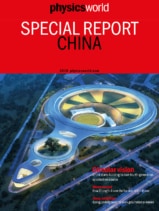This year marks a major anniversary in our exploration of the Moon – it’s 50 years since the astronauts aboard Apollo 11 stepped onto the lunar surface for the fist time. While people have not returned to the Moon since the Apollo 17 mission in 1972, the exploration of our nearest neighbour is far from over.
 Indeed, for the past decade, China has had a particular lunar focus, planning and launching a series of robotic missions. And earlier this year China did something that no other country had done before – put a lander on the side of the Moon that always faces away from Earth, known as the far side.
Indeed, for the past decade, China has had a particular lunar focus, planning and launching a series of robotic missions. And earlier this year China did something that no other country had done before – put a lander on the side of the Moon that always faces away from Earth, known as the far side.
In the fifth and latest Physics World special report on China – following previous reports in 2011, 2016, 2017 and 2018– we take an in-depth look at China’s Chang’e-4 mission to the far side, which landed in the Von Kármán creator in the South Pole Aitken Basin on 3 January.
Yet China does not just have its sights set on space. As outlined in the free-to-read special report, the country is also forging ahead in synchrotron science, notably through the construction of a major fourth-generation synchrotron radiation facility in Beijing – the fourth such synchrotron in the country. And earlier this year physicists in China unveiled ambitious plans to build a massive new underground facility in the centre of the country to study gravitational waves and test Einstein’s general theory of relativity to an unprecedented precision.
Here is a run-down of what’s in the free-to-read issue:
• China plans gravitational-wave observatory – A new facility in central China is designed to study gravitational waves as well as test Einstein’s theory of general relativity to unprecedented precision, as Ling Xin reports
• Exploring the far side – China’s Chang’e-4 mission became the first probe to touch down on the far side of the Moon earlier this year. Ling Xin examines the consequences for lunar exploration
• China’s next big thing – Work has just begun on China’s first fourth-generation synchrotron radiation source. Robert P Crease gets a sneak preview of what’s in store
• Peering into the past – Robert P Crease talks to researchers in China who use physics-based techniques to understand the country’s history
I hope you find this special report interesting, and if you’d like to share your thoughts on it, please get in touch by e-mailing us at pwld@iop.org.



